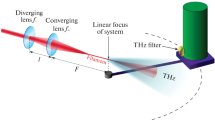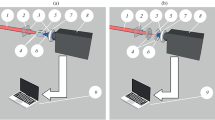Two-dimensional distribution patterns of terahertz radiation generated in a laser single-color filament plasma are measured at several frequencies. In the low-frequency region (0.1–0.5 THz), the radiation propagates in a cone with a minimum on the axis. At higher frequencies, the terahertz radiation pattern depends significantly on the laser pulse polarization. In the case of linear polarization, the axial symmetry is broken: terahertz radiation propagates into two maxima located along the axis perpendicular to the laser polarization. In the case of circular polarization, the axial symmetry of the terahertz radiation distribution is restored.
Similar content being viewed by others
Avoid common mistakes on your manuscript.
Terahertz radiation of plasma channels [1], formed under filamentation of femtosecond laser pulses [2, 3] in air has been studied since mid-1990s. The propagation of terahertz radiation from a single-color filament in a cone with a minimum on the axis was observed in numerous works, e.g., [4, 5]. These experimental studies were carried out with significantly different detectors: a narrowband heterodyne detector sensitive to a frequency of about 0.1 THz [4] and a bolometer operating in the frequency range from 0.1 to 3 THz [5]. The terahertz radiation pattern obtained in [6, 7] is completely different and has two maxima located in the vertical axis for the horizontal polarization of a pump laser pulse. The authors of many works considered the spectrum of terahertz radiation [8] and its angular distribution [4] separately. However, the angular pattern of individual spectral components is rather poorly studied [9]. Therefore, the aim of this work is to measure spectrally resolved two-dimensional distributions of terahertz radiation of a single-color filament.
We carry out the experiments on a Ti:sapphire laser system (Avesta) with a central wavelength of the pulse of 740 nm. The pulse duration is 90 fs, the laser beam diameter is 8 mm (FW1/eM). At the output of the laser system, radiation has a horizontal polarization. Half- and quarter-wave plates are used to obtain vertical and elliptical polarization, respectively. We clean the beam by passing it through a diaphragm 6 mm in diameter and focus it by a spherical mirror with a focal length of 50 cm, which corresponds to the numerical aperture NA = 0.006. The pulse energy after the diaphragm is 1.5 mJ. In the filamentation region in air, we observe the formation of a plasma channel, which is a source of terahertz radiation recorded by a superconducting NbN bolometer (Scontel) with a detection range from 0.1 to 6 THz. In front of the bolometer input window, we place a 3-mm Teflon plate to cut off optical radiation and narrowband terahertz filters to detect signals in certain spectral ranges [9, 10].
In order to measure two-dimensional terahertz radiation patterns (THz in Fig. 1), two angles are varied independently. To change the horizontal angle HA, we rotate the bolometer B in the plane of the optical table around the axis passing through the focal point. The vertical angle VA is varied by the rotation of the laser beam propagation axis around the focus. The plane mirror MP directs the beam to the spherical mirror MS, providing the minimum angle of incidence so as to reduce astigmatism. The mirror MS is moved along the vertical stand, and both mirrors are aligned to restore the position of the laser beam focus.
(Color online) Experimental scheme: (MP) plane mirror, (MS) spherical focusing mirror, (HA and VA) horizontal and vertical angles, (B) bolometer, (THz) terahertz radiation, and (f) geometrical focus position. The laser beam is shown in red and the filamentation region is orange. The optical axis of the laser beam at zero horizontal and vertical angles, its projection on the table and the projection of the line connecting the focus f and the bolometer input window are indicated as white lines.
Prior to the experiments on the detection of terahertz radiation, we have ensured that a single plasma channel emerges under our conditions at a pulse energy of 1.5 mJ. For this purpose, a fused silica wedge is placed in the filamentation region; the image of the beam fluence distribution on the wedge is detected by a CCD camera. Transverse profiles are recorded with a step of 1 cm along the beam propagation axis. A bright filament surrounded by a low-intensity reservoir is observed in a 3-cm-long region in front of the geometric focus in the transverse distribution, which indicates the formation of a single plasma channel.
During the experiments we obtained the angular patterns of terahertz radiation with frequencies of 0.1, 0.3, 0.5, and 1 THz. Figure 2 shows the distribution of 0.3-THz radiation. The measured distribution at frequencies of 0.1–0.5 THz has a ring-like structure; i.e., terahertz radiation propagates in a cone with the minimum on the axis, complying with the previously observed data [4, 5]. Although terahertz radiation is generated by a single plasma channel, it is quite inhomogeneous and has a few local minima and maxima.
In contrast to the low-frequency components of terahertz radiation, the distribution pattern at about 1 THz has two pronounced maxima (Fig. 3a) on the vertical axis, similar to [6, 7]. As in [6, 7], the results presented in Figs. 2 and 3a are obtained for the horizontal polarization of the laser beam. When the polarization of the laser beam is rotated by 90°, the distribution of 1-THz radiation is also rotated (cf. Figs. 3a and 3b). In the case of the elliptically polarized laser pump (ratio of the ellipse axes is 0.6), the pattern has a ring‑like structure (Fig. 3c).
To date, there is a number of models of terahertz generation by the single-color filament. The models proposing light pressure [11] or ponderomotive force [12] as the nonlinear terahertz generation mechanism predict the axisymmetric angular distribution at any frequency and any polarization of optical pump pulse. In simulations carried out in [13] under the conditions of the experiments [6, 7], the authors reproduced a modulated ring structure in the two-dimensional fluence distribution of terahertz radiation from the single-color filament. The fluence maxima in [13] are located on the axis perpendicular to the polarization of the femtosecond laser pump pulse. Nevertheless, in these simulations [13] the modulation of the ring was only ~20%, while the dip between the lobes in [6, 7] and in our experiments at a frequency of ~1 THz is significantly deeper. Therefore, up-to-date models for terahertz radiation from the single-color filament do not reproduce the two-dimensional angular patterns observed in our experiment.
To summarize, frequency-resolved two-dimensional terahertz radiation patterns from the single-color filament have been studied experimentally for the first time. It has been shown that the shapes of distributions in the low- and high-frequency parts of the terahertz spectrum are qualitatively different. While radiation with the frequencies of 0.1–0.5 THz propagates in the cone with the minimum on the axis at any polarization of the femtosecond pulse, the radiation pattern for a frequency of ~1 THz has two pronounced maxima on a straight line perpendicular to the polarization plane of the initial laser pulse. In the case of circular polarization, the radiation pattern is a hollow cone similar to that observed at lower frequencies.
The results obtained in this work can clarify the apparent discrepancy between the angular distributions of terahertz radiation from the single-color filament detected in [4, 6]. The authors of [4] measured the angular distribution of the low-frequency (~0.1 THz) component of electromagnetic radiation, so the terahertz radiation had the conical radiation pattern. In [6], the angular measurements were not spectrally selective, while the independent spectral measurements indicated that the terahertz spectral maximum appeared at a frequency of about 1 THz. Thereby, the radiation patterns with two maxima located perpendicularly to polarization plane of optical pump were observed in [6] for radiation with the spectrum near 1 THz. The two considered types of terahertz radiation patterns from the single-color filament are in reasonable agreement with the patterns observed in this work for low and high frequencies.
Change history
19 January 2023
An Erratum to this paper has been published: https://doi.org/10.1134/S0021364022380027
REFERENCES
H. Hamster, A. Sullivan, S. Gordon, W. White, and R. W. Falcone, Phys. Rev. Lett. 71, 2725 (1993).
S. L. Chin, S. A. Hosseini, W. Liu, Q. Luo, F. Théberge, N. Aközbek, A. Becker, V. P. Kandidov, O. G. Kosareva, and H. Schroeder, Can. J. Phys. 83, 863 (2005).
A. Couairon and A. Mysyrowicz, Phys. Rep. 441, 47 (2007).
C. D’Amico, A. Houard, M. Franco, B. Prade, A. Mysyrowicz, A. Couairon, and V. T. Tikhonchuk, Phys. Rev. Lett. 98, 235002 (2007).
A. P. Shkurinov, A. S. Sinko, P. M. Solyankin, A. V. Borodin, M. N. Esaulkov, V. V. Annenkov, I. A. Kotelnikov, I. V. Timofeev, and X. C. Zhang, Phys. Rev. E 95, 043209 (2017).
R. A. Akhmedzhanov, I. E. Ilyakov, V. A. Mironov, E. V. Suvorov, D. A. Fadeev, and B. V. Shishkin, Radiophys. Quantum Electron. 52, 482 (2009).
E. Suvorov, R. Akhmedzhanov, D. Fadeev, I. Ilyakov, V. Mironov, and B. Shishkin, J. Infrared Millim. Terahertz Waves 32, 1243 (2011).
Y. Zhang, Y. Chen, C. Marceau, W. Liu, Z.-D. Sun, S. Xu, F. Théberge, M. Châteauneuf, J. Dubois, and S. L. Chin, Opt. Express 16, 15483 (2008).
L. V. Seleznev, G. E. Rizaev, D. V. Pushkarev, A. V. Koribut, Y. A. Gerasimova, Y. V. Grudtsyn, S. A. Savinov, Y. A. Mityagin, D. V. Mokrousova, and A. A. Ionin, J. Opt. Soc. Am. B 38, 2168 (2021).
I. A. Nikolaeva, D. E. Shipilo, D. V. Pushkarev, G. E. Rizaev, D. V. Mokrousova, A. V. Koribut, Y. V. Grudtsyn, N. A. Panov, L. V. Seleznev, W. Liu, A. A. Ionin, and O. G. Kosareva, Opt. Lett. 46, 5497 (2021).
C. D’Amico, A. Houard, S. Akturk, Y. Liu, J. le Bloas, M. Franco, B. Prade, A. Couairon, V. T. Tikhonchuk, and A. Mysyrowicz, New J. Phys. 10 (1), 013015 (2008).
N. A. Panov, O. G. Kosareva, V. A. Andreeva, A. B. Savel’ev, D. S. Uryupina, R. V. Volkov, V. A. Makarov, and A. P. Shkurinov, JETP Lett. 93, 638 (2011).
N. A. Zharova, V. A. Mironov, and D. A. Fadeev, Phys. Rev. E 82, 056409 (2010).
Funding
This work was supported by the Russian Foundation for Basic Research, project no. 20-02-00114. D.E. Shipilo acknowledges the support of the Council of the President of the Russian Federation for State Support of Young Scientists and Leading Scientific Schools (project no. SP-3450.2022.2). I.A. Nikolaeva acknowledges the support of the Foundation for the Advancement of Theoretical Physics and Mathematics BASIS (project no. 21-2-10-55-1).
Author information
Authors and Affiliations
Corresponding author
Ethics declarations
The authors declare that they have no conflicts of interest.
Rights and permissions
Open Access. This article is licensed under a Creative Commons Attribution 4.0 International License, which permits use, sharing, adaptation, distribution and reproduction in any medium or format, as long as you give appropriate credit to the original author(s) and the source, provide a link to the Creative Commons license, and indicate if changes were made. The images or other third party material in this article are included in the article’s Creative Commons license, unless indicated otherwise in a credit line to the material. If material is not included in the article’s Creative Commons license and your intended use is not permitted by statutory regulation or exceeds the permitted use, you will need to obtain permission directly from the copyright holder. To view a copy of this license, visit http://creativecommons.org/licenses/by/4.0/.
About this article
Cite this article
Rizaev, G.E., Mokrousova, D.V., Pushkarev, D.V. et al. Breaking of the Axial Symmetry of Terahertz Radiation from Single-Color Filament Plasma. Jetp Lett. 115, 657–659 (2022). https://doi.org/10.1134/S0021364022600732
Received:
Revised:
Accepted:
Published:
Issue Date:
DOI: https://doi.org/10.1134/S0021364022600732







